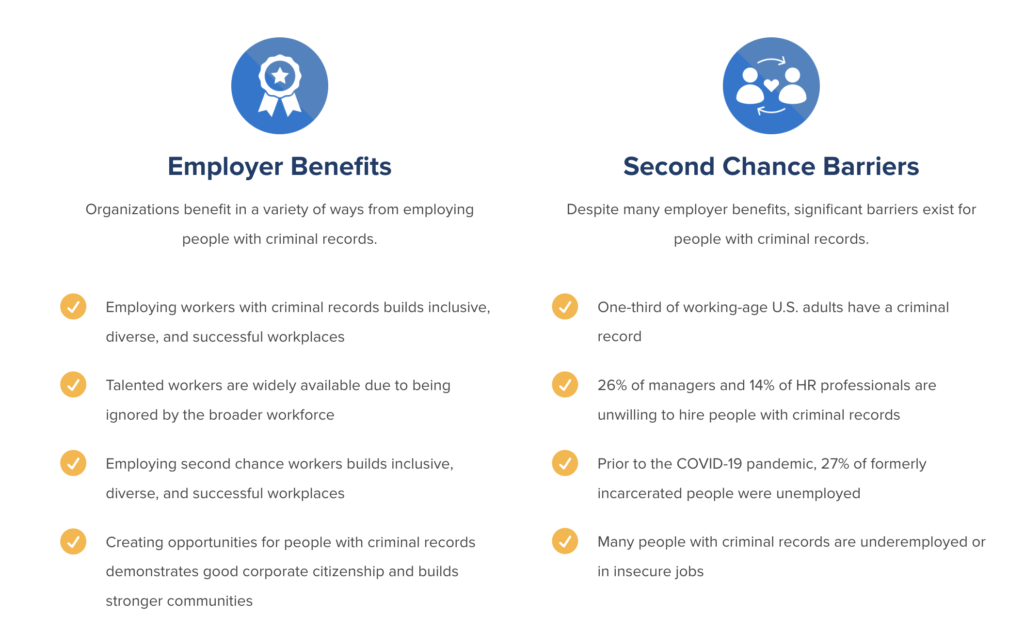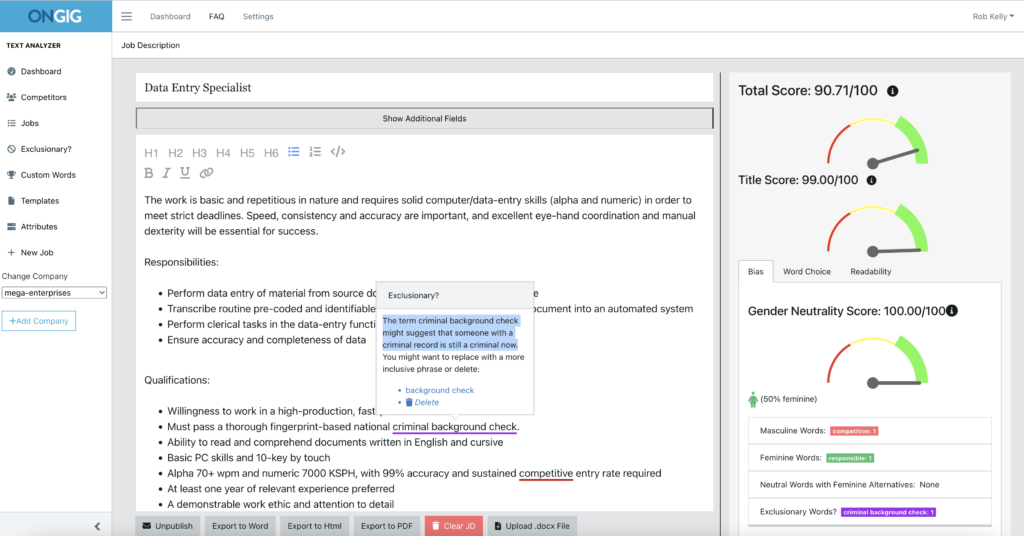- 6 Tools for Hiring People with Criminal Backgrounds - May 25, 2022
We’re in an era of increasing demands for accountability and transparency in all aspects of business. So, employers want to know that their employees are trustworthy and reliable. As a result, many of them are reluctant to hire people with criminal backgrounds. This is especially true when they don’t have the right tools for hiring.
Second chance hiring means giving people with a history of breaking the law another chance at a job. It’s about looking at what they can bring to the company instead of saying no just because of their past mistakes.
Here are 6 tools (and programs) for second chance hiring.
Workforce Development Programs
Hiring felons is a challenge. Former felons are not often welcome in the workforce due to their criminal history and represent an untapped talent pool. But when you hire people with criminal records, you open yourself up to risks that can lead to litigation, employee turnover, and increased costs.
So, to reduce these risks, you can use a program that checks if job applicants have a criminal record and gives them training before hiring. In some places, there are programs that connect employers with people who have a small criminal record. These people need training or job experience to get back on the right path.
And companies like Walmart, Starbucks, Home Depot, and JPMorgan Chase are updating their hiring practices to include people with criminal records.
Another example is Nehemiah Manufacturing, where second chance hiring is the norm. Nehemiah has created a Second Chance program that includes a social-service team, housing and drug treatment support, and an assigned job coach.
In a 2020 interview about Second Chance Companies, Co-Founder of Nehemiah, Richard Palmer, said:
“We found that the population we were hiring who had criminal backgrounds were our most loyal people. When we were looking for people to work overtime, come in on Saturday or go that extra mile, it was the second-chance population that was saying, ‘I’m in.’”
source: NAM.org
SHRM’s Getting Talent Back to Work Program
Many people with criminal backgrounds are good employees. They tend to be more loyal and they dedicate themselves to the company as a sign of gratitude for getting a second chance.
However, a lot of managers don’t want to hire people with a criminal history. That’s why programs like Getting Talent Back to Work try to change this thinking and promote giving people a second chance at a job.
Getting Talent Back to Work is an initiative by the SHRM Foundation to help employers open up to hiring people with criminal records. People who are disproportionately affected by unemployment. So, this program focuses on reducing employment barriers through education, change management, and cultural transformation.
Here are some benefits for employers and some second chance hiring barriers highlighted by SHRM:

Ongig’s Text Analyzer Software
When hiring formerly convicted employees, Ongig’s software helps you create more inclusive job descriptions. Recruitment stats show the language used in a job posting can attract (or deter) relevant candidates. So, it’s crucial to create job postings that make former felons feel welcome and encouraged to work at your company.
Ongig is a tool that assists employers in making job ads that work well and includes everyone. The software points out words that might make people with a criminal history not want to apply, like “criminal background check,” “convicted felon,” or “ex-felon.” It suggests more inclusive words to use instead.
Here’s an example of “criminal background check” flagged in Ongig with a pop-up showing a more inclusive replacement:

HRIS Systems
A Human Resources Information System (HRIS) is a powerful tool for hiring people with criminal backgrounds. A good HRIS system helps you easily keep track of information about employees (and applicants), including their criminal history.
This includes everything from arrest dates and charges to conviction dates and sentences. So, you’ll be able to make more informed decisions about who gets hired and who doesn’t.
HRIS systems are useful through all stages of the hiring process — from applications to background checks. They also make it easier for you to manage your business by providing data entry, reporting, and analysis tools.
Background Check Tools
Employers use background check tools to uncover criminal records, credit history, and other information that might affect a candidate’s ability to do the job. Background checks also give you an idea of how well a potential employee performs in a position. And it also shows if they’ll add to your workplace culture.
There are loads of helpful background check tools to find out if someone has a criminal record. But, before using one, try to do a quick check on your candidate using People Finder. This platform has an extensive database of people who may have served time in prison.
Tools to Handle Sensitive Information
Handling sensitive information is one of the main concerns for employers hiring people with a criminal record. Sharing details about someone’s criminal history via video conference software or other communication tools might be necessary. But it also carries the risk of a privacy breach.
Good news! There are some tools to make the hiring process more secure and efficient. Using VoIP software ensures any sensitive information you’re handling, like criminal records of your potential candidates, is securely communicated with the hiring team.
Another thing you can do to avoid the risk of privacy breach is to sign an NDA – non-disclosure agreement. There are many tools you can use to find templates and generate NDAs automatically. The purpose of some mutual NDAs is to protect the “secret sauce” of a business and to protect confidential criminal history details of new hires.
Why I wrote this:
Second chance hiring opens up your talent pool and give former felons the opportunity to start a new chapter of their life. Learn more about how Ongig helps you create effective and inclusive job descriptions for second chance hires and other underrepresented groups.
This is a guest post from Georgi Todorov.
Georgi is the founder of ThriveMyWay, a website dedicated to teaching successful digital marketing strategies. Georgi is regularly called upon by companies seeking to develop and enhance their SEO and link-building strategies in order to achieve hockey stick growth. When Georgi isn’t working, you can find him getting close to nature, learning online, or traveling.

Shout-outs:
- Securing housing after incarceration (Bankrate)
- What to Know About Second Chance Hiring and Why It Could Help Solve Your Labor Problems (by Emily Heaslip)
- What Makes a Good Employee? What to Look for During The Hiring Process (by Deanna deBara)
- Building Better Opportunities for People with Criminal Records (by Getting Talent Back to Work)
- How to Find the Right HRIS System for Your Business? (by Sakshi Jain)
- Top Recruitment States and Trends 2022 (by THRIVE My Way)
- 9 Employee Background Check Software to Use Before You Make Your Next Hire (by Dhruv Parmar)
